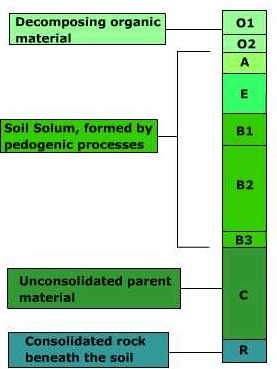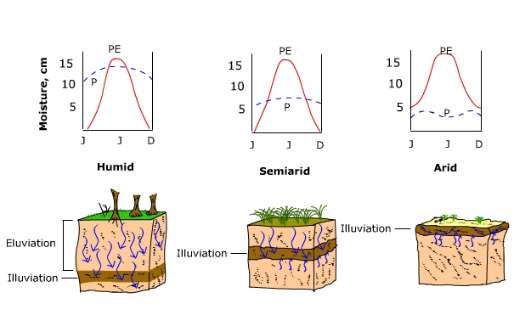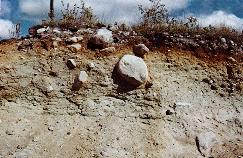11.4: Soil Profiles
- Page ID
- 16131
Soil formation begins first with the break down of rock into regolith. Continued weathering and soil horizon development process leads to the development of a soil profile, the vertical display of soil horizons. Watch the typical progression of a soil profile then read the description below of a generic, fully developed soil.

O Horizon
At the top of the profile is the O horizon. The O horizon is primarily composed of organic matter. Fresh litter is found at the surface, while at depth all signs of vegetation structure has been destroyed by decomposition. The decomposed organic matter, or humus, enriches the soil with nutrients (nitrogen, potassium, etc.), aids soil structure (acts to bind particles), and enhances soil moisture retention.
A Horizon
Beneath the O horizon is the A horizon. The A horizon marks the beginning of the true mineral soil. In this horizon organic material mixes with inorganic products of weathering. The A horizon typically is dark colored horizon due to the presence organic matter. Eluviation, the removal of inorganic and organic substances from a horizon by leaching occurs in the A horizon. Eluviation is driven by the downward movement of soil water.
E Horizon
The E horizon generally is a light-colored horizon with eluviation being the dominant process. Leaching, or the removal of clay particles, organic matter, and/or oxides of iron and aluminum is active in this horizon. Under coniferous forests, the E horizon often has a high concentration of quartz giving the horizon an ashy-gray appearance.
B Horizon
Beneath the E horizon lies the B horizon. The B horizon is a zone of illuviation where downward moving, especially fine material, is accumulated. The accumulation of fine material leads to the creation of a dense layer in the soil. In some soils the B horizon is enriched with calcium carbonate in the form of nodules or as a layer. This occurs when the carbonate precipitates out of downward moving soil water or from capillary action. The diagram below illustrates the effect of climate on eluviation and illuviation. Eluviation is significant in humid climates where ample precipitation exists and a surplus in the water balance occurs. Illuvial layers are found low in the soil profile. Illuvial zones are found closer to the surface in semiarid and arid climates where precipitation is scarce. Capillary action brings cations like calcium and sodium dissolved in soil water upwards where they precipitate from the water.

C Horizon
The C horizon represents the soil parent material, either created in situ or transported into its present location. Beneath the C horizon lies bedrock.

The preceding paragraphs describe a generic soil profile, yet not all soils have each one of the horizons, nor are they all the same with respect to thickness composition and structure. Newly formed "immature" soils may only have an O-A-C sequence while older more "mature" soils display the full profile of horizons as described above. The particular compositional, structural and chemical composition of the soil depends on the various factors that influence soil formation.


